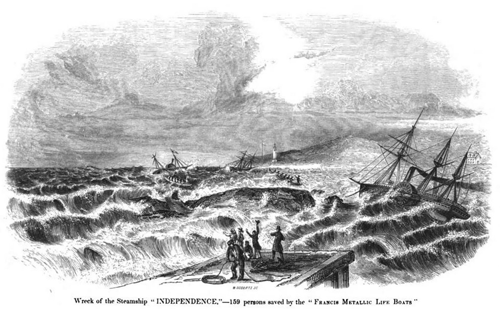
SS Independence Wreck
Period drawing from an advertisement for metal life boats showing attempts to rescue the passengers and crew from the Morgan Steamship SS Independence wrecked at the entrance to Pass Cavallo in 1852, the depiction of the surrounding terrain is not accurate.
Picture Source Francis’ Metallic Life-Boat Company Advertisement
In Part II of my Pass Cavallo history series, I will briefly describe the history of Pass Cavallo and the surrounding area from 1840 through the Civil War to the late 1800’s.
The town of Indianola was established around 1844 and became one of the most important Ports along the Texas Coast in the 1800’s. Indianola was located along Matagorda Bay near present day Magnolia Beach. Ships regularly passed through Pass Cavallo to reach Indianola, which grew to become the largest city in Calhoun County.
In 1847, on the Western side of Pass Cavallo on Matagorda Island, several hundred acres were sectioned off to form the town of Saluria. The Town of Saluria was on the Southeast side of present day Saluria Bayou. At Indianola, Warehouses were built along with ship docks, which were used primarily by well-known Morgan Ship Lines. The Morgan Lines was the first Steamship Company in Texas and was founded by Charles Morgan. Most of the Steamships that sailed from New Orleans to Galveston and Indianola were owned by the Morgan Lines. Ships would enter Pass Cavallo and unload at Saluria or Indianola. In Saluria, the cargo from the ships would be loaded onto smaller ships and taken into Matagorda Bay. The Saluria Post Office was opened in 1848, and an 1850 census showed 164 residents of Saluria.
In 1852, a lighthouse was built on Matagorda Island near Pass Cavallo. The 55-foot cast iron lighthouse was originally erected on the northeast end of Matagorda Island at the entrance to Pass Cavallo. It was painted with red, white, and black horizontal stripes to make it visible at the time. The lighthouse was raised 24 feet by adding a section to the middle of the structure in 1857.
One notable shipwreck before the Civil War was the brand new Morgan Steamship SS Independence, which wrecked at the entrance to Pass Cavallo on March 26, 1852. The Independence was carrying cargo and 120 passengers plus the crew. After becoming stuck on the sandbar at the entrance to Pass Cavallo, a rescue operation was launched. After several smaller wooden boats were smashed to pieces in the waves attempting to rescue the passengers, the U.S. Mail Steamship Louisiana launched two metal lifeboats which managed to rescue a majority of the remaining passengers before the Independence broke up in the surf.
The Civil War was fought from April 12, 1861 to May 26, 1865. The Civil War started after eleven of the then thirty-four states withdrew from the United States and formed their own country. Texas was one of the eleven “Southern” states, and a new country was formed known as the “Confederate States of America”. The remaining states in the United States were known as the “Union”. While I’m not going to go into the causes or reasons behind the Civil War, it was a bloody conflict, with over 850,000 troops on both sides killed. In some instances brothers, fathers, sons, and other family members fought against each other on the opposing sides. When the war ended, the Union had won and the United States was changed forever.
During the Civil War, Confederate Forces built Fort Esperanza on the Western Side of the Pass Cavallo channel to guard against any Union Ships that might attempt to sail through the Pass. The Fort consisted of nine foot high earthen / dirt walls which were around twenty foot thick at the base of the walls. Fort Esperanza was equipped with nine cannons, and trenches / rifle pits for troops were also added farther south along the channel. One cannon was positioned on the North side of Saluria Bayou in its own earthen position.
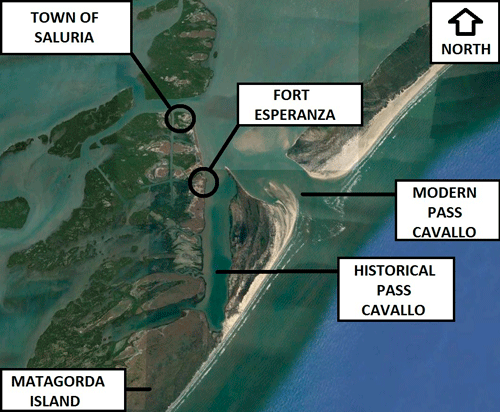
Pass Cavallo Civil War:
Satellite Picture of the Pass Cavallo Area in 2016 with labels added showing the present day locations of the town of Saluria and Fort Esperanza – Picture Source Google Earth
After Galveston was captured by Union Troops, Union Forces turned their attention to Calhoun County. Most of the residents of Saluria had already evacuated when news arrived that Union troops had gone ashore in Corpus Christi. Confederate troops at Fort Esperanza attempted to blow up the Matagorda Lighthouse, but only succeeded in damaging the lower section. In October of 1862, Union Ships landed troops on the South West end of Matagorda Island; these troops attacked Fort Esperanza from the rear and drove out the Confederate defenders. Union Ships then sailed up the Pass and shelled Indianola and Port Lavaca. After Confederate Forces recaptured Galveston in December 1862, the Union Forces lacked the troops to hold the area and withdrew, Confederate Troops then re-occupied and repaired Fort Esperanza.
In November of 1863, Union forces once again attacked Fort Esperanza. This time a Confederate Gunboat named the John F. Carr participated in the defense. The Carr was operated by the Texas Marine Department, also called the Texas Marine Brigade, which was organized by the Confederate Government early in the war to defend the coastal waters of Texas. Most of the 25 vessels operated by the Texas Marine Department were converted from cargo and passenger vessels. Commanded by James R. Marmion, the Carr was equipped with two cannons and had cotton bales as makeshift armor. In addition to the Carr, the Confederates also had the armed schooner Buckhart, and the gunboat Cora in Matagorda Bay.
December 30, 1863, found the Carr and Cora sinking two boats carrying Union Troops to Matagorda Island from the ships offshore, 18 Union troops drowned. On Dec 31st to Jan 1st, the Carr closed in to Matagorda Island and fired on the Union troops, “making some very good hits,” This happened around Dec 31st 1863 – Jan 1st 1864. This information was from the log of the USS Sciota, which was one of the Union ships supporting the Union forces.
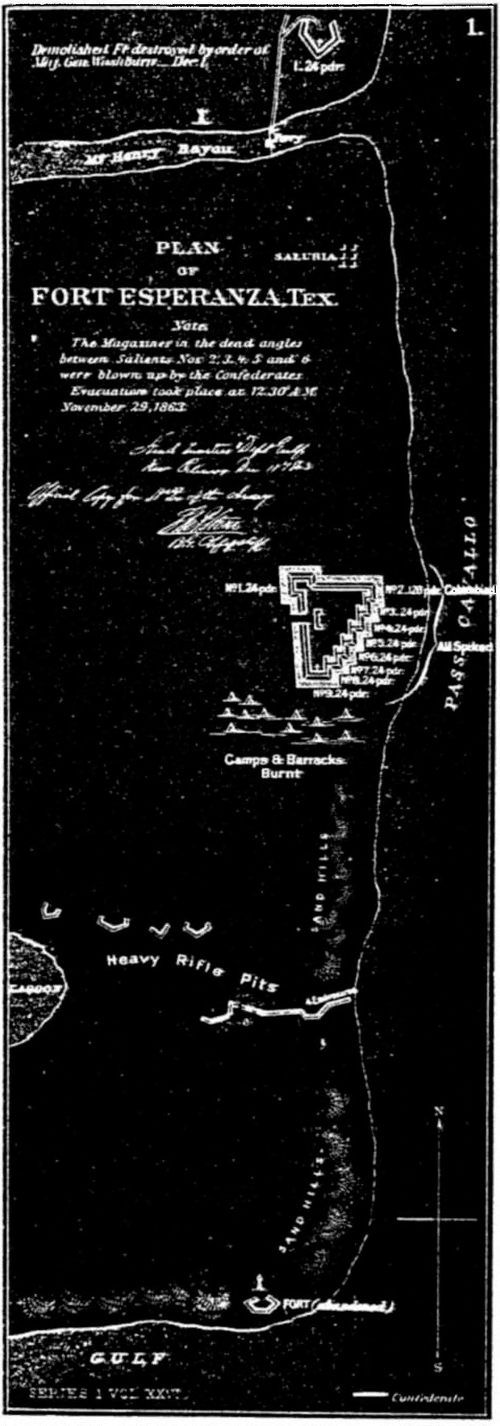
Fort_Esperanza_1863:
1863 Drawing of Fort Esperanza
The Confederate troops eventually retreated again after blowing up the ammunition stored in Fort Esperanza. There were several conflicting stories about the date and exact location, but the John F.Carr was lost in the vicinity of Pass Cavallo sometime in early 1864. Some reports say that the gunboat was driven on a sandbar during a Norther and intentionally burned, while other reports say that it was sunk by Union Forces. Union Forces left Matagorda Island again on June 15, 1864 and Fort Esperanza was re-occupied by the Confederates troops who held it until the end of the Civil War on May 26, 1865.
After the Civil War, the damaged Matagorda Island Lighthouse was disassembled and moved further inland. A new foundation was made, damage was repaired, and the lighthouse reassembled. Equipped with a new light assembly and a fresh coat of flat black paint, the Matagorda Island Lighthouse was put back in service on September 1, 1873. From 1879 to 1880, a station for the United States Life-Saving Service was built and manned on Matagorda Island. The Life-Saving Service was the predecessor to the modern day Coast Guard. This station was known as “Station Saluria” and its first commander was Daniel Simpson.
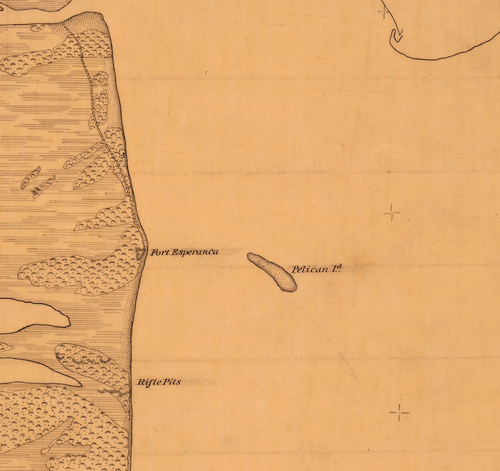
Another Drawing of Fort Esperanza
Indianola was devastated by a hurricane in 1875 which killed up to 300 people. The town was rebuilt on a smaller scale until devastated again by a hurricane in 1886; by 1887 the town of Indianola was mostly abandoned. These hurricanes washed away the walls of Fort Esperanza and today little remains. A few people held out in the town of Saluria until it was abandoned in the early 1900’s.
In the next Pass Cavallo article, I will write about the shipwreck searches that occurred in the Pass Cavallo area from 1998 to 2001.
Many thanks for assistance in writing this article go to Steve Hoyt, formerly with the Texas Historical Commission, Henry Wolff Jr. of Victoria, and the U.S. Navy Historical Center. Additional thanks to Gaylen Youngblood, Elmer DeForest, and Kenny Finster.
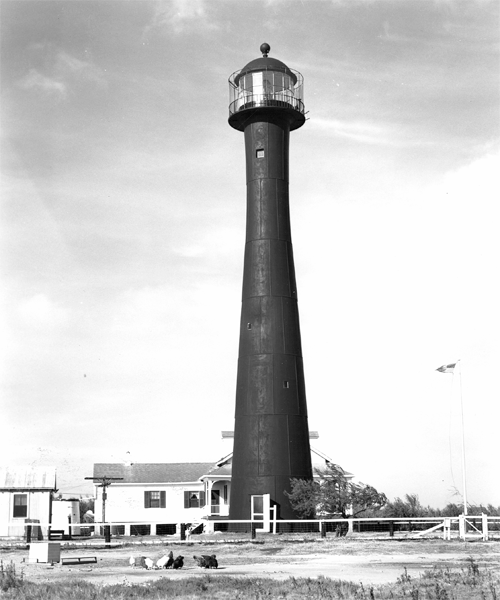
Picture of the Matagorda Island Lighthouse in the early 1900’s – Picture Source United States Coast Guard Archives
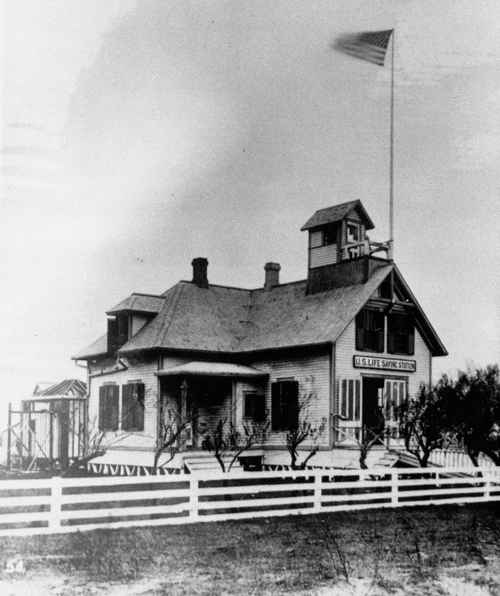
United States Life-Saving Station Saluria on Matagorda Island– Picture Source Wexford Archives
